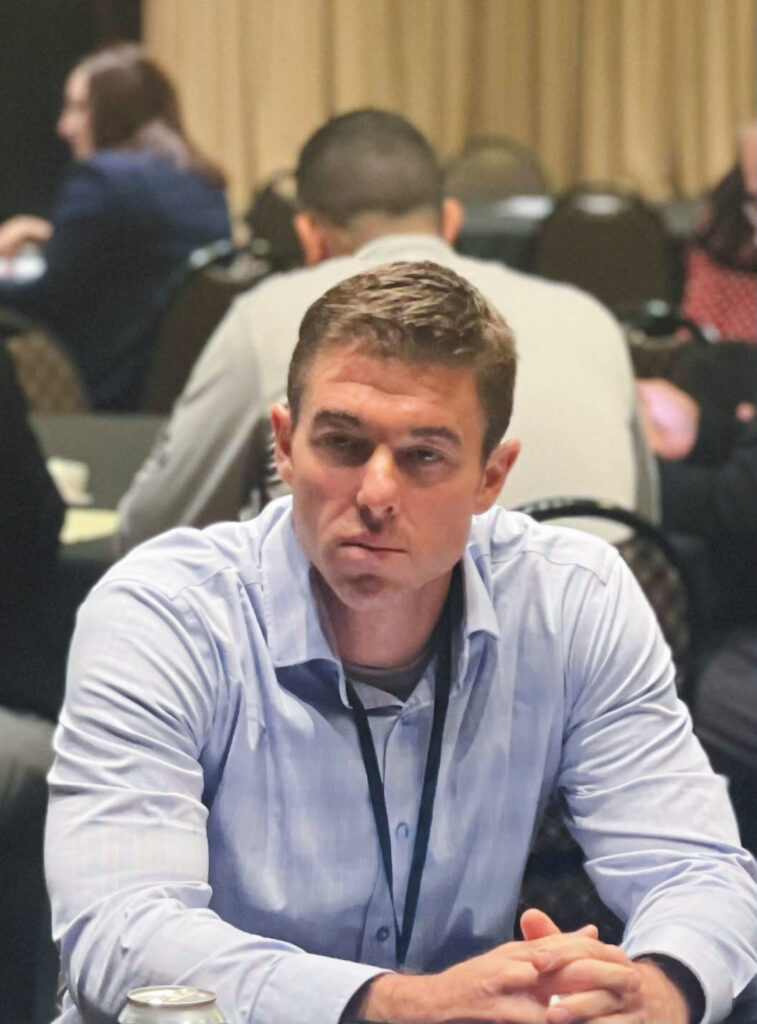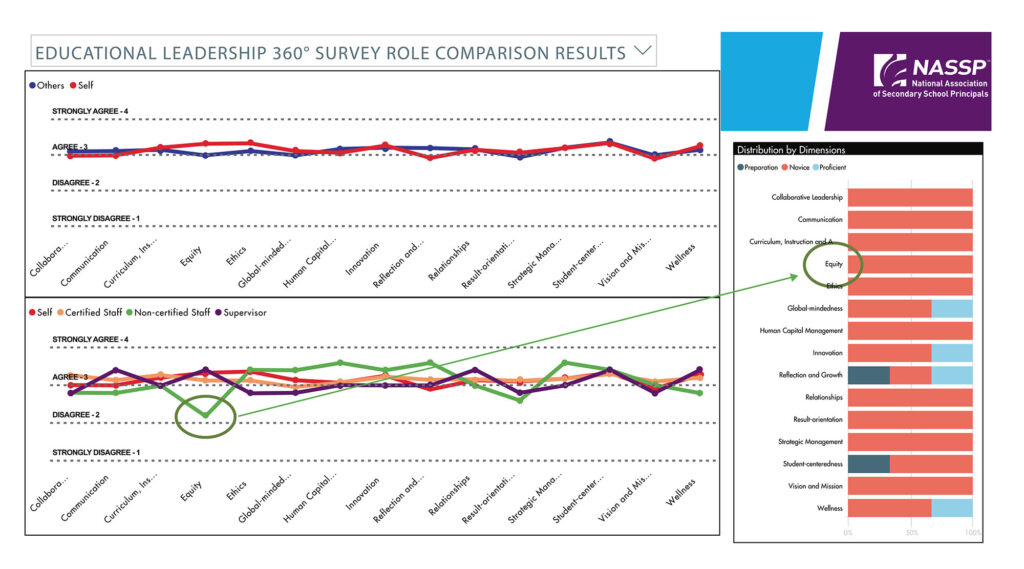The 360° Leadership Survey
“School leadership is second only to teaching among school-related factors in its impact on student learning, according to research. Moreover, principals strongly shape the conditions for high-quality teaching and are the prime factor in determining whether teachers stay in high-needs schools. High-quality principals, therefore, are vital to the effectiveness of our nation’s public schools, especially those serving the children with the fewest advantages in life. An effective principal’s impact is stronger and broader than previously thought, making it “difficult to envision’’ a higher return on investment in K–12 education than the cultivation of high-quality school leadership.
—Wallace Foundation, February 2021

Improving the leadership in a school is a multifaceted process that requires a combination of leadership strategies. And with the many challenges building principals face day in and day out, it can seem like an unattainable goal. But improving leadership doesn’t have to be a mystery to be solved or happen by accident. There is a science behind improving school leadership and learning that can be aided by using the 360° Leadership Survey.
Three years ago, our team at United School Administrators of Kansas (USAKS), where I serve as the director of professional learning, began using the survey coupled with individual leadership coaching (if a school leader registers for the survey, they also register for coaching). Since then, we have seen an increasing number of administrators employ their leadership to successfully strengthen the culture and learning within their schools.
The survey assesses the leadership characteristics to build culture in the building and the ability of the principal to effectively lead the learning process. These two domains, creating a positive culture and leading the learning, are then broken down into 15 dimensions that help leaders identify areas of strengths as well as areas for improvement.

Through USAKS, principals with a minimum of one year’s experience in their current role at a school building can enroll to access this survey, which presents a valuable professional development opportunity. Once registered, staff at USAKS assign the principal the survey through the NASSP Building Ranks Portal. The principal then shares the survey with their certified staff, non-certified staff, and their immediate supervisor. The principal is also required to complete a self-assessment, which is key in allowing the school leader to reflect on how they perceive their leadership and how their perspective about their leadership aligns to their staff and supervisor’s perceptions. The survey should take no more than 15 minutes for a staff member to complete. With our state’s school leaders, we like to emphasize the importance of not overthinking the statements within the survey. Open-ended questions are available at the conclusion of the survey, which allows staff to provide more detailed feedback related to any of the questions.
Once the survey has been completed (the window for completion we give is typically two weeks), the results are populated on the USAKS Building Ranks dashboard. The results are compiled in a report, which is released to the school leader for their analysis and reflection. As the system administrator, our team can access and analyze the results. The report is shared with the USAKS staff member assigned as the administrator’s coach for their review before the first coaching session.
It is important to note that we do not share the results with anyone other than the building principal and the coach. We believe this is crucial in creating a safe, trusting relationship between the school leader and the USAKS staff member who will be assigned as their individual leadership coach. If a superintendent or someone from the board of education asks to review the results, we defer to the building principal to share their results as they see fit.
Following the distribution of the survey, the principal is assigned a USAKS staff member as their individual leadership coach. This coach has served as a building principal and has completed training on coaching at the Kansas Leadership Center. Coaches have all led for at least 10 years, and several have district-level leadership experience; they are not acting building leaders. The coach and principal meet monthly over the course of a school year. During the first coaching session, the pair analyzes and discusses the results of the survey in depth. This first session typically takes two hours as the coach and principal take time to get to know each other, analyze results either through specific prompts in the report or by the principal completing their own self-reflection, and then discuss target areas of improvement. They then work together to identify an area(s) of strength and weakness inside each domain as well as discrepancies between the principal’s self-assessment score and the scores of staff members who rated them. These areas of interest drive the coaching conversations forward. Principals receive a copy of the Building Ranks K–12 Comprehensive Framework for Effective School Leadership guide to support growth and understanding of each dimension within the two domains.
The survey assesses the leadership characteristics to build culture in the building and the ability of the principal to effectively lead the learning process.
Most often, school leaders elect to first focus on strengthening their leadership in the dimensions of culture identified from the analysis of the survey results. Depending on the needs of the building, this focus may take a semester or the entire school year before the leader can expand their focus to leading the learning processes in their school. During coaching conversations, the principal identifies root causes for identified challenge areas (such as a lack of trust or the lack of a clear instructional model) that may be impacting their ability to build the culture or lead learning. The principal works with the coach to identify action steps to complete within the upcoming month to improve their leadership in these areas. Following the coaching session, notes are captured and shared with the principal for their review and implementation. These ongoing coaching conversations help increase clarity and accountability for the building leader to move forward with changes to strengthen their school leadership.
We recommend leaders engage in at least two years of coaching before readministering the survey to their staff. Over the last three years, almost all our school leaders have chosen to continue coaching for the recommended two-year window. Our coaches have worked with principals who have years of experience and numerous awards and those who believe their positions may be on the line.

Thanks to the survey, we have seen most of the school leaders make drastic changes in how they lead their schools to build the culture and strengthen student learning. We have also helped others find their way to securing their positions or deciding to change new ones. A very small few have decided the role of the principalship is no longer their passion, and that’s OK. Regardless, survey outcomes have yielded the results that provide the right perspective for individual leaders and their schools.
Making the Job Less Lonely
Leading can be a lonely job and building the culture and learning in a school can seem like an insurmountable challenge. Our association has found that the use of the 360° Survey coupled with individual leadership coaching helps alleviate the loneliness of the position and provides the accountability needed to strengthen culture and learning in a school. Having individual leadership coaches who have successfully sat in the seat of the principalship is key in helping leaders navigate the challenges they face in improving their leadership performance.
We recommend both the survey and leadership coaching as professional learning resources for school leaders following the completion of a multi-year leadership pathway. At USAKS, we believe that learning for leaders is critical to improving our schools. We know that professional development must be relevant, research based, job embedded, and ongoing to create accountability at the building level. We also emphasize the need for school leaders to connect with colleagues so they can build a strong professional network—another effective way to assist our principals in leading as learners.
For more information, visit nassp.org/building-ranks/building-ranks-educational-360o-survey.
Jessica Griffin is the director of professional learning at United School Administrators of Kansas.
